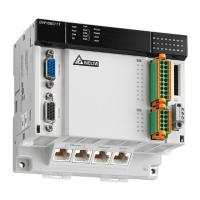DVP-15MC Series Motion Controller Operation Manual
8-332
different meaning when the value of the input DiagType varies.
When the value of the input DiagType is 1, the value of Node means whether slaves are configured in
the software. TRUE means that slaves are configured in the software. FALSE means slaves are not
configured in the software.
When the value of the input DiagType is 2, the value of Node means whether slaves make the
connection with CANopen port. TRUE means the connetion is made. FALSE means the connetion is
not made.
When the value of the input DiagType is 3, the value of Node means whether slaves release
Emergency message. TRUE means Emergency message has been sent. FALSE means Emergency
message has not been sent.
E.g. if the value of DiagType is 2 and the variable of the output Node is a, the value of a[1] is TRUE
when slave 1 and CANopen port make the connection and the value of a[1] is FALSE when the
CANopen cable of slave 1 is removed.
Programming Example
1. The variable table
2. The program
From the values of members of the CSD_Node array, you can figure out if the corresponding slave is
connected to CANopen communication port of the controller or not.
If CSD_Node[1]=1, it indicates that axis 1 and CANopen communication port have been connceted, if
the CSD_Node[1]=0, it indicates that axis 1 and CANopen communication port have not been connected.
The possible reason is that the communication cable between CANopen communication port and axis 1
is not connected properly or the communication cable is unplugged after being plugged in.
For the connection of axis 2 to CANopen communication port, you can use the value of CSD_Node[2]
to judge whether the connection is successful or not.
For the connection of other axes to CANopen communication port, use the same way to judge whether
the connection is successful or not.
1
CANopen_SysDiag
Enable Done
CSD
DiagType Error
ErrorID
Node
CSD_En
CSD_DT
CSD_Node

